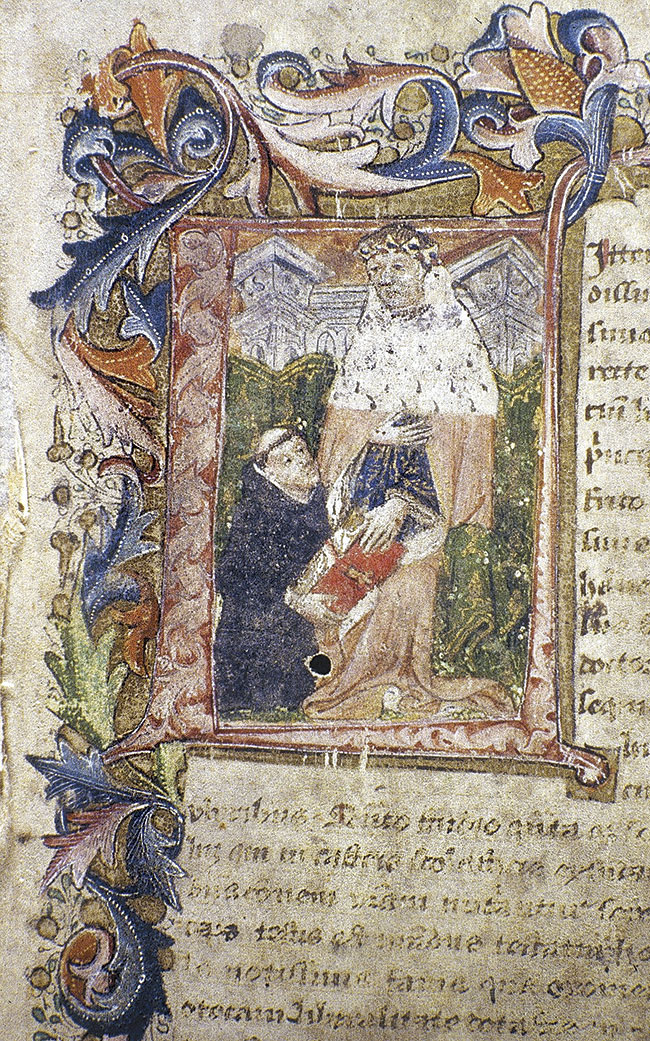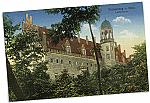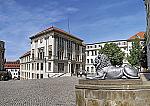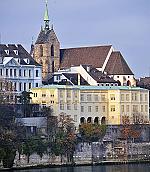A guild of learners

[MS Humfrey b1 Commentary on Exodus, initial of John Capgrave presenting his manuscript to Humphrey, Duke of Gloucester, 1440, Bodleian Library—Unknown scribe / [Public domain] Wikimedia]
What guild created no wares and sold nothing tangible? Established to teach and prepare qualified learners, this guild spread and gathered apprentices to further the cause of its specialized trade. But it did not sell wares like a merchant or create something tangible as a metalsmith might. The trade was scholarship; the craft, and even the knowledge, of theology—a commodity considered more important to a thriving life on earth than any of the material goods of the other trades.
Apprenticed to the craft
More than 800 years ago, after a century of extensive (but not terribly organized) provision of higher education in England, a group of scholars in Oxford established themselves as a universitas, Latin for “corporation.” The corporation took “apprentices” (undergraduates) and “journeymen” (partially qualified craftsmen who had achieved the bachelors of arts).
Masters of arts served as guild masters and taught the students, “ruling” the guild as regents. They trained students to lead the church as well as law courts, halls of government, and the trades. As in any other guild, the masters organized the syllabus for training, then examined the candidates, giving those who passed the appropriate gradus, or “degree,” in the guild. Like any other apprenticeship, the process, begun in adolescence, could take seven years to complete, during which the student would first gain the degree of bachelor of arts before attempting the MA.
Despite strict university standards for guild membership, would-be students simply arrived and applied to a regent master, who would place them on his register (the origin of the word “matriculation,” or “registering”). While their education eventually brought many of these students into positions of public service, nonuniversity residents of university towns sometimes wondered whether they were worth the trouble.
Disputes between students and local people were an early problem, especially over lodgings. For this reason students hoped to enter the university quickly.Matriculated scholars enjoyed some legal protections, while unregistered hangers-on did not. Sheriffs could imprison students just for being unregistered. Beyond registering, students had to go to class; only scholars who went to lectures at least three times a week (assuming the master had actually lectured on those three days) enjoyed immunity.
A town-and-gown clash over a presumed murder left three students dead and became the occasion for the birth of a second English university, Cambridge; Oxford became known as its “parent.” The University in the Fens of East Anglia (its original name) began in 1208 or 1209 when some scholars had to leave Oxford after the conflict. A resident body of practicing canon lawyers working in the diocese of Ely may account for the decision of the refugees to settle in nearby Cambridge. Theirs survived as a new university while other experimental scholar settlements failed. Cambridge’s practical arrangements continued largely to mirror those of its parent school for centuries.
The late eleventh and twelfth centuries had seen “wandering scholars” attaching themselves to famous masters and clustering near cathedrals, which had had schools for centuries. Those cathedral schools had produced advanced scholarship and famous controversies on theological topics. But the Universities of Paris and Oxford, and soon Cambridge, provided a new institutional structure in northern Europe.
Clerks and clerics
Students attracted to both Oxford and Cambridge were both would-be clerks and would-be clerics. Only after becoming an MA could a student begin to study theology or law for a higher degree. That could take many more years, into the student’s forties—and it might not happen at Oxford or Cambridge. From 1088 a growing European demand for qualified notaries and highly educated civil servants was met by a “business school” in Bologna; during the twelfth century, it became a graduate studium specializing in the teaching of law. Meanwhile Paris offered theology as a postgraduate degree. Theology, law, and medicine would remain postgraduate degree subjects throughout the Middle Ages at Oxford, Cambridge, and elsewhere.
Everywhere the undergraduate syllabus looked the same, derived from the seven liberal arts of the classical world. The set books were taught by lecturing (lectio, literally “reading”), for it was some generations before local stationers (stores selling writing materials) hit on the idea of renting sections of a text to students as the lecturer made his way through the book. Normally the lecturer would read a sentence or two and then pause to explain difficult words, or to compare the opinions of authorities who had commented on the passage in earlier generations. Teaching methods reflected the emphasis on logic; points in dispute were taught in formal disputations. There the master presided and then declared the “correct” interpretation.
Passing the test
No one could become a master of arts without satisfying the examiners of his universitas that he knew this syllabus in a disputation held for the purpose. Oral disputation long remained the method of examining a candidate for a degree; Cambridge’s Senate House examinations became written papers only in 1828, and Oxford too kept up examination by Latin disputation into the nineteenth century. The disputation survives today in doctoral defenses (where candidates must answer questions orally—although no longer in Latin) and at Oxford for some undergraduate degree candidates.
The holder of these higher degrees was known (interchangeably) as master or doctor. To attain a doctorate in theology involved studying the Latin Vulgate and also what would now be called systematic theology. The Sentences (sententiae, or “opinions”) collected by Peter Lombard (c. 1096–1160) had by now become the standard textbook. Lombard compiled and organized the views of early Christian authors dealing with key themes and principles of Christian theology. Hundreds of manuscript commentaries on the Sentences survive.
Every would-be doctor in theology would spend a period lecturing on Scripture when he reached the interim level of bachelor of theology. The lecturer usually chose from the Psalms and the Epistles. That did not prevent the adventurous from exploring other parts of the Bible. Robert Grosseteste (c. 1168–1253) was one of a number of students intrigued by scientific questions arising out of the story of creation in Genesis. (Read more about Grosseteste in CH 134.)
Franciscans and Dominicans quickly appeared in Oxford and Cambridge, each existing as a new kind of religious order with a mission to preach. Preachers needed a good education, and both orders wrangled with the universities over the order in which the syllabus should be covered. The question of preaching was contentious; while only a university had power to grant degrees, it might not have authority to permit its graduates to preach. That lay with bishops: the bishop of Lincoln for Oxford and the bishop of Ely for Cambridge.
Academic infighting began early in both universities and grew fiercer through the medieval centuries as more and more scholars left legacies of their opinions in commentaries. Such infighting could also break out into national politics, as it did for John Wycliffe (c. 1320–1384); see CH #3. He made himself unpopular chiefly over his views on “dominion” and the standing of clergy and nobility—making enemies, for instance, of the by now very powerful friars.
“Hot-headed men”
The whole question of the teaching and study of the Christian faith in Oxford and Cambridge took on a new color with the Renaissance, when study of the Bible in the original languages of Greek and Hebrew was introduced. The Reformation outlawed much medieval doctrine and practice. Oxford and Cambridge revised the syllabus, under some pressure from the Tudor monarchy, no longer teaching only the set books of the Middle Ages. Many colleges had required fellows (in modern terms, alumni) to gain the degree of bachelor in divinity, which meant they had studied the Sentences; now royal injunctions of 1543 to 1547 forbade lectures on the Sentences.
Eventually some books from the original syllabus physically vanished: Humphrey of Lancaster had left his library of 281 books to the University of Oxford (which until then had only owned about 20 books) when he died in 1447, but in 1550 the king’s commissioners stripped the library to end the study of Roman Catholic learning, possibly burning the books.
During Catholic Mary Tudor’s reign, many of Oxford’s and Cambridge’s Protestant theologians took refuge in Europe until they could safely return. When Mary’s sister, Elizabeth, succeeded to the throne, she took a firmer hand in governing both universities than any monarch before her. In 1565 Cambridge’s Statutes were reformed: “though some few hot-headed men there made some opposition. . . . But by the most and best part” they were “consented to.”
Oxford and Cambridge had been composed of medieval colleges, independent corporations in their own right, with fellows making up the corporate bodies. But colleges with generous benefactors now began to multiply as part of the universities with the dissolution of the monasteries. These colleges now admitted students and presented them to the university for matriculation, and it became a requirement that students should subscribe to the Thirty-Nine Articles of the Church of England. That ended only with the University Tests Act of 1871. Graduates offered fellowships were normally expected to be ordained in the Church of England, so Anglicanism long maintained a strong presence in Oxford and Cambridge.
Today both schools are governed as direct democracies by a “sovereign body” (Oxford) or a “governing body” (Cambridge) composed of academics and academic-related staff. Although the guild has evolved into these modern forms, in a sense the two schools are still corporations of scholars. CH
By G. R. Evans
[Christian History originally published this article in Christian History Issue #139 in 2021]
G .R. Evans was formerly professor of medieval theology and intellectual history at the University of Cambridge. She has published widely on medieval history and theology and is the author of The University of Oxford: A New History and The University of Cambridge: A New History.Next articles
The backwoods school that changed a continent
How Wittenberg helped spread Protestant reform
Beth KreitzerTolerant and pious
How Friedrichs University in Halle gave Europe a Pietist vision of the common good
Douglas H. ShantzSupport us
Christian History Institute (CHI) is a non-profit Pennsylvania corporation founded in 1982. Your donations support the continuation of this ministry
Donate







